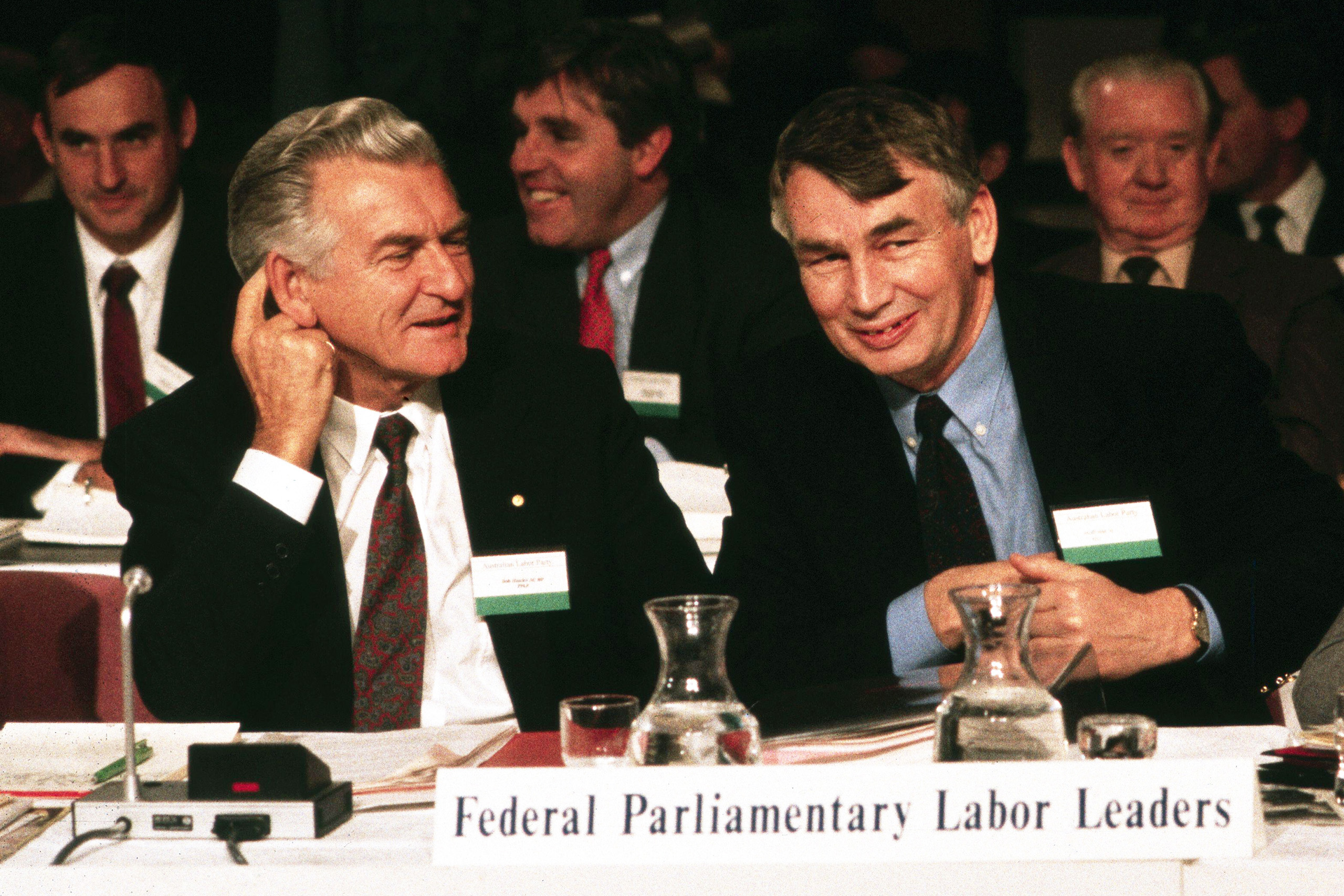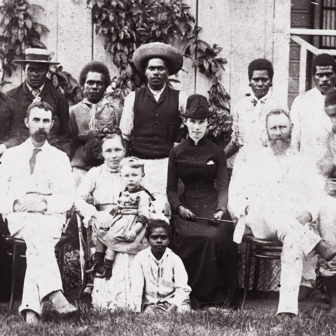As a historian with a close interest in contemporary policy, John Murphy is well aware of the need to learn carefully from past successes, failures and debates. But few decision-makers or influencers in politics, the media and elsewhere seem to agree, and even relatively recent experiences are ignored or misdescribed with disturbing frequency. Failures become triumphs, successes are derided or forgotten. Belated recognitions become inspired discoveries.
Murphy’s latest book, An Unlikely Survival: The Politics of Welfare in Australia Since 1950, provides a wealth of material for a better-informed debate about Australia’s welfare policies, together with thoughtful interpretations and analysis. Covering almost seventy-five years, it takes Australia from the beginning of the long postwar boom to the recovery from the worst of Covid-19.
Murphy’s account begins with twenty-plus years of unbroken Coalition government, including all of the the 1950s and 60s, when industrialised countries like Australia were relatively stable economically, with opportunities for growth and little competition from outside their ranks. Economic and social structures were based overwhelmingly on the traditional family of a husband in paid work and a wife raising their children and doing other unpaid work. Full-time and secure employment was readily available. Wage levels were protected by high tariffs and centralised arbitration.
Social security debates during this period focused mainly on whether pensions for older people and allowances for families with dependent children should be available to all or exclude the well-off. Prime minister Robert Menzies insisted on keeping the existing pension means test (although it became more generous), adding a special supplement for low-income renters. The special tax relief and “child endowment” payments for families with dependent children were not means-tested, and those in greatest need were hardest hit by a lengthy failure to adjust payments for inflation.
During these years the tax system provided financial assistance for personal expenditure on healthcare, superannuation and education. The greatest benefit was for higher-income people, who could afford to pay more than those on lower-incomes and then get a higher rate of deduction per dollar spent. The regressive impact of this “tax welfare,” as Murphy aptly calls it, was to some degree offset by free government schooling and free healthcare for many low-income people (partly through the pioneering pharmaceutical benefits scheme).
Post-Menzies, with economic and social certitudes starting to falter, the 1970s were a transitional period. Unemployment eventually rose steeply, reflecting not just global developments but also Australia’s particular vulnerabilities and economic policies. Under prime minister Gough Whitlam, Labor encouraged large wage rises but added downward pressure by hugely reducing tariffs. The Medibank system of universal health insurance, free university education and government grants for private schools helped many people of modest means. Although a generous share of the benefits went to middle- and high-income groups, some of their tax welfare for spending on health and education was cut back.
Labor raised and generously indexed the pension rate and freed it from means-testing. A new social security payment for sole parents was much better directed at a growing number of people in real need. Unemployment was tackled more by programs to help people find work than by higher social security payments. But teething problems and public prejudice hampered attempts to focus help on people facing the greatest obstacles to getting a job. Public housing and transport infrastructure were substantially boosted, partly recognising location as a key cause of hardship and disadvantage. So, too, was funding to improve conditions for Indigenous people.
After less than four years, the Coalition returned to office under Malcom Fraser. Having inherited a very high level of inflation and unemployment rising from a low base, its seven years in power ended with lower inflation but very much higher unemployment. Attempts to reduce wages and working conditions tended to be most effective where least justifiable. Labor’s universal health insurance scheme, Medibank, was dismantled in favour of private insurance. Other spending cuts fell unduly on lower-income people, although the age pension was raised and very generously protected from inflation. The level of unemployment benefit fell far behind.
Having recently agreed to the principle of equal pay for men and women, the national wage authority stopped considering the cost of children when setting basic wage rates. The Coalition cut tax relief for families with dependent children to help fund a new family payment system that, although it wasn’t means-tested, reduced some of the previous largesse for higher-income parents. The existing income supplement for unemployed families was matched by a new one for those on very low wages. An innovative program funded remote communities to develop projects that would provide some paid work for local Indigenous people.
Labor returned to government under Bob Hawke in 1983 facing challenges and opportunities very different from a decade earlier. Multinationals operating in low-wage countries were competing more vigorously with local manufacturers. Deregulated financial markets were exerting greater and more immediate power over businesses and governments around the globe. Taxation and government expenditure had become political pariahs, at least within the Anglosphere, with treasurer Paul Keating an especially fervent convert to the cause.
The new government rapidly discarded core promises to protect wages and jobs. Key aspects of the economy were carelessly deregulated. Deliberate cuts in tax revenue and public expenditure were unprecedentedly severe. The main victims included schools, hospitals, transport and other essential economic and social infrastructure. Many Australians benefited from the surge in borrowing and property speculation, especially if they were already wealthy. But many who had already been struggling became worse off.
The Hawke–Keating period saw more innovation in welfare policy than at any other time during the seventy-five years. Some developments were admirable and of great long-term benefit. Others moved in the right direction but were poorly designed or badly under-funded. Some harsh cutbacks, however, fell mainly on people who were already in great distress.
Murphy rightly identifies the restoration of an improved Medibank, now Medicare, as a major achievement of Hawke’s government, and also singles out higher family payments for low-income people. The funding came partly from new means tests on pensions and family payments, although the decision to exclude pensioners’ homes from the test further inflated house prices and sacrificed a great deal of revenue. The new family payments system was carefully designed to reduce the risk of low-income people coming to rely solely on social security, but an excessively severe means test on unemployment benefit often had the opposite effect.
Murphy’s special praise for Labor’s compulsory superannuation scheme is much less persuasive. It provided wildly generous tax concessions for higher-income people but little or no benefit for those on low incomes. And, as the flat rate of compulsory contributions began rising, so did the gross unfairness of the tax concessions and the excessive interference in how lower-income people could build and draw on their financial resources.
The praise for Labor’s decision to increase rent assistance and extend it to a wider range of low-income people also needs heavy qualification as the gains were largely outweighed by increases in house prices and rentals. Property inflation was fuelled by extravagant financial deregulation, inadequate taxation of capital gains from housing and unlimited scope for negative gearing. The damage for low-income people was made worse by cutting funds for public housing.
With many more women taking on paid work by choice or necessity, the government began significantly increasing the supply of childcare places. Subsidies for aged care were also expanded, partly because Australians in frail health were living longer. In each case the intentions were admirable, but when the subsidies were extended to commercial operators little effort was made to adequately regulate quality and prevent neglect of low-income areas. A new child support scheme helped many sole parents to get reasonable maintenance from the other parent but only, of course, if they could be found and reasonably forced to pay.
An overall assessment of the Hawke government’s impact on wellbeing, however, must take full account of the economic policies that drove the country into its longest period of severe unemployment since the Great Depression of the 1930s. The official rate climbed to 11 per cent and the proportion in long-term unemployment rose even more alarmingly. Help to survive financially and improve employability was grossly belated and inadequate.
The Coalition, now led by John Howard, returned to power in the mid-1990s. Unemployment eventually fell below the pre-recession level but remained too high. People still unable to find enough work to survive got even less help than before, and more harassment. The trend towards lower wages and less job security was accelerated. But the family payment system was improved in some ways, including a reasonably balanced concern for one-earner families and, albeit belatedly, a lump-sum maternity payment.
Having promoted alarm at the mounting public cost of an ageing Australia, the Coalition indulged in what Murphy rightly calls a “rather shameless habit of handouts to key voting blocs, particularly the elderly.” The pension means test was considerably relaxed, largely so that part-pensioners in even more comfortable circumstances could get the increasing array of pensioner concessions from governments at all levels. The largesse began to spread to older people who were too well-off to get a pension. A last-minute election panic led the Coalition to abandon its opposition to Labor’s promise to hugely increase the compulsory contribution rate for superannuation. But neither party offered much to reduce the scheme’s unfairness and cost to government.
Howard’s government largely maintained Medicare, although it intensified the pressure on households to insure privately. Commercial operators got a much larger share of the funding for child and aged care services. Government-run job-help services were replaced by funding for mainly commercial operators. Some move in these directions was justifiable, but there was too much emphasis on competitively funding lowest-cost services without ensuring basic integrity, quality and a focus on the people in most need. Extra funding for private education spawned a huge increase in the number of schools controlled by vigorously religious groups.
As with its Labor predecessor’s policies, the Coalition’s economic and tax decisions caused a great deal of unnecessary hardship and unfairness. Too much of the new GST revenue was wasted on unjustifiably large income tax cuts for the wealthy. Slashing the capital gains tax rate by 50 per cent caused profound economic and social damage, especially by hugely increasing the tax incentives for property speculation. Housing costs were inflated even further, aggravated by government grants to first homebuyers that did little more than enable sellers to demand even higher prices.
Murphy rightly describes the fifteen years or so from the end of Howard to the beginning of Albanese as “chaotic, frequently dysfunctional and largely unproductive.” There was surprisingly little difference between Labor and Coalition governments. Social security was degraded by harsh cutbacks in support for sole parents and unemployed people. Commercialisation continued to increase the supply of aged care, childcare and job programs without ensuring quality and transparency. Taxation of capital gains and superannuation remained inexcusably wasteful and damaging. The HECS loan scheme for university studies, always very problematic, became more unfair.
On the other hand, extreme economic theories were cast aside in Labor’s response to the global financial crisis and the Coalition’s to the Covid-19 pandemic. Labor’s innovative National Rental Assistance Scheme and National Disability Insurance Scheme were potentially very beneficial, but the former was scuppered by poor implementation and Coalition bloody-mindedness while the latter remains in the hands of the jury. The Community Development Employment Program for Indigenous people in remote areas was abandoned, both sides of politics having contributed to its early successes but then letting it spread beyond where it was most needed and likely to be effective.
Murphy’s title, An Unlikely Survival, reflects his belief that Australia has suffered less than other industrialised countries from the resurgence of laissez faire ideologies because the accompanying “refurbishment” of our welfare system during the Hawke–Keating years has been modified but not dismantled. He acknowledges the risk of seeming too generous in his assessments, however, and rightly doesn’t claim that our current system responds adequately to hardship or at least as well in every respect as some other countries. The book’s breadth and balance, including the number of appropriately strong criticisms, might have been better reflected by a different title.
In any event, the welfare system is rarely the greatest influence on wellbeing, especially for people in greatest need. The biggest challenge for Australian welfare policy in recent decades has been to offset the unnecessary and unfair damage caused by extreme, unprincipled and incompetent economic policies. The gap between the wellbeing of the highest- and lowest-income households has become inexcusably and dangerously larger. The 1980s and 90s, in particular, saw both parties competing to import economic ideologies with little regard for Australia’s unique circumstances. As Murphy points out, the extremism of the Coalition’s Fightback! platform for the 1993 election “helped Labor turn the spotlight way from its own record of neoliberalism.”
It’s important not to over-rely on some measures of economic or social change when considering whether things have got better or worse, or are better here than in the countries. Politicians and pundits often give undue weight to apparent changes in income (pre- or post-tax) without recognising their limited validity, even in relation to income itself, let alone to broader wellbeing. Among other factors, the real significance of shifts in income can be greatly affected by changes in the cost of housing and essential services, especially if they are misleadingly adjusted for inflation by relying solely on the general CPI. Wealth is often a much more significant determinant of financial wellbeing, especially as its distribution has become so much more unequal since the 1980s.
The overarching analyses in Murphy’s introduction and epilogue are highlights of the book, as is its extensive collection of statistical tables. Overall, it provides an invaluable awareness of past policies and experiences that has so often been absent when current or proposed ones are being assessed in the corridors of power or the melee of public debate. •
An Unlikely Survival: The Politics of Welfare in Australia Since 1950
By John Murphy | Melbourne University Press | $50 | 408 pages




